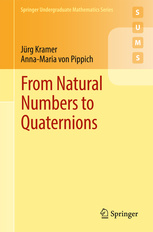Description
From Natural Numbers to Quaternions, 1st ed. 2017
Springer Undergraduate Mathematics Series
Authors: Kramer Jürg, von Pippich Anna-Maria
Language: German
Subject for From Natural Numbers to Quaternions:
Keywords
MSC (2010): 08–01, 11–01, 12–01, 20–01, integers construction, rational numbers construction, real numbers construction, complex numbers construction, Hamiltonian quaternions construction, group theory elements, ring theory elements, complex numbers algebraicity, proof transcendence Euler number e, Associative Rings and Algebras, Commutative Rings and Algebras, Field Theory and Polynomials, Group Theory and Generalizations, Number Theory
Approximative price 36.91 €
In Print (Delivery period: 15 days).
Add to cart277 p. · 15.5x23.5 cm · Paperback
Description
/li>Contents
/li>Biography
/li>Comment
/li>
This textbook offers an invitation to modern algebra through number systems of increasing complexity, beginning with the natural numbers and culminating with Hamilton's quaternions.
Along the way, the authors carefully develop the necessary concepts and methods from abstract algebra: monoids, groups, rings, fields, and skew fields. Each chapter ends with an appendix discussing related topics from algebra and number theory, including recent developments reflecting the relevance of the material to current research.
The present volume is intended for undergraduate courses in abstract algebra or elementary number theory. The inclusion of exercises with solutions also makes it suitable for self-study and accessible to anyone with an interest in modern algebra and number theory.
Jürg Kramer is Professor of Mathematics at the Humboldt-Universität zu Berlin, Germany. His research focuses on arithmetic geometry, in particular on Arakelov geometry, and the theory of modular and automorphic forms. He is also interested in questions about the teaching of mathematics at university level.
Anna-Maria von Pippich is Junior Professor of Algebra and Number Theory at the Technische Universität Darmstadt, Germany. She is working in number theory, in particular in the theory of automorphic forms, and Arakelov geometry.
Provides a self-contained introduction to the construction of integers, rationals, reals, complex numbers and Hamilton's quaternions
Develops the basic prerequisites in group and ring theory as well as elementary number theory
Contains appendices to each chapter highlighting the ubiquity of the material
Includes more than 100 exercises with solutions
Includes supplementary material: sn.pub/extras

